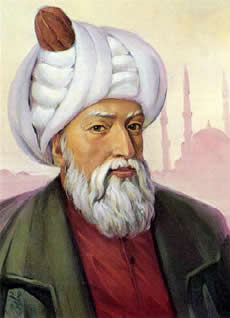Abdul-Menan Sinan - Ottoman Architect
 |
| Abdul-Menan Sinan |
He was selected for the elite Janissaries and served in several military campaigns, where he became a noted engineer building bridges and other structures.
He served as the major architect for sultans Suleiman I the Magnificent and Selim II (the sot) and became the empire’s chief architect (mimbar bashi). During his long and productive life, Sinan designed more known buildings than any other architect in history.
He built mosques, hammams, mausoleums, aqueducts, and palaces. Building on ideas from earlier Byzantine designs, particularly the Aya Sopia in Istanbul, Sinan struggled to surpass the grandeur and size of the dome in that great Byzantine church.
Sinan’s Suleimaniya complex in Istanbul has a mosque with a huge central dome supported by two half-domes giving the appearance of soaring in the air; the mosque, with tall needle shaped minarets, opens onto a courtyard with a portico, a style much favored in Ottoman architecture. The vast complex, with over 400 domes in total, also includes schools, a hospice, a soup kitchen, and commercial shops to support the social work of the complex.
Sinan also built the elaborately decorated Rustem Pasha mosque for the grand vizier as well as the tombs for Suleiman’s son Mehmed and Suleiman’s beloved wife, Hurrem Sultan (Roxelana); these are adorned with brightly colored Iznik tiles in deep blues and reds. In his autobiography, Sinan rated the Selimya mosque in Edirne, outside Istanbul, as his masterpiece owing to its huge central dome, which seems to float over a vast open interior space.
Sinan died in 1574 at the age of 99 and is buried in a simple tomb close to one of his greatest accomplishments, the Suleimaniya complex.
- Al-azhar
Al-Azhar The Fatimids established al-Azhar, one of the oldest universities in the world, in Cairo in 970. Built around a large mosque with an open courtyard surrounded by columned walkways where classes were taught, al-Azhar quickly became one of the...
- Art And Architecture In The Golden Age Of Muslim World
Art and Architecture in the Golden Age of Muslim World Islamic art and architecture is that of the Muslim peoples, who emerged in the early seventh century from the Arabian Peninsula. The Muslim empire reached its peak during the golden age of Islam from...
- Isfahan (persia)
Isfahan (Persia) In 1592 Shah Abbas I made Isfahan the capital of the Safavid Empire. In an earlier era, Isfahan had been the capital of the Seljuk Empire, but under Shah Abbas the city became a major economic and cultural center or as the Persian saying...
- Mehmed Ii - Ottoman Sultan
Mehmed II - Ottoman Sultan Mehmed II (reigned 1444–46; 1451–81) was only 12 years old when his father, Murad II, abdicated to pursue a life of religious contemplation (following Sufi or Islamic mysticism) and appointed him sultan in 1444....
- Selim Ii - Ottoman Sultan
Selim II - Ottoman Sultan Suleiman I the Magnificent’s last surviving son, Selim II (r. 1566–75), became sultan of the Ottoman Empire when the empire was at the zenith of its power and glory. Although Selim was a gifted poet, his notorious...
